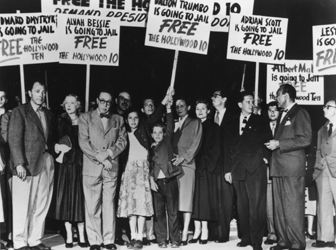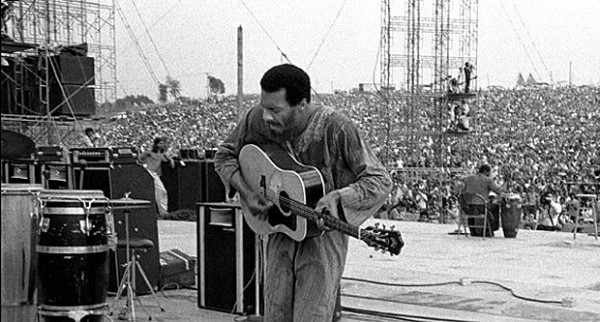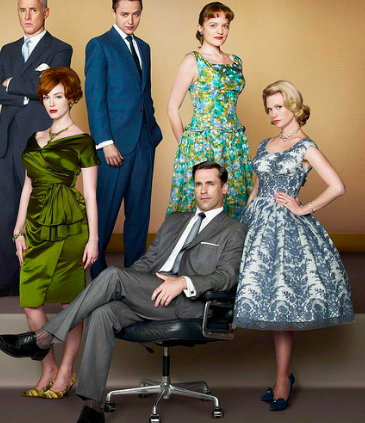Blog
Hollywood Blacklist
[Blog] The Hollywood Blacklist
August 28, 2014
Author: Megan O’Toole

Members of the Hollywood Ten and their families in 1950, protesting the impending incarceration of the ten. Source: Creative Commons.
In the golden age of Hollywood, many film industry employees fueled a stable “studio system” by signing contracts with a select number of major studios. Between the years 1927 to 1963, five large studios including Metro-Goldwyn-Mayer and Paramount Pictures controlled the film industry–creating thousands of efficiently-made movies. Yet this system, which bolstered Hollywood’s economy, was rattled when politics started to play a stronger role in the production and distribution of films following World War II.
The reoccurrence of the Red Scare and the threat of communism led many talented individuals in Hollywood to face accusations of membership in the American Communist Party. The alleged communist members were threatened with being “blacklisted,” a practice that banned a person from any future employment in the film industry.
Continue reading
Charles Brooks Jr.
[Blog] Accounts of the First U.S. Prisoner to Receive Lethal Injection
August 13, 2014
Author: Megan O’Toole
There are some crimes that are deemed too horrible to be punished by a lifetime of imprisonment alone. The United States has wrestled over whether or not a death penalty should be implemented in exceptional circumstances that require another level of retribution.
Continue reading
Pacific Crest Trail
[Blog] The Pacific Crest Trail’s History & Rise to Prominence
August 6, 2014
Author: Robbie Faselt
“In every walk with nature, one receives far more than he seeks.” -John Muir
The Pacific Crest Trail (PCT) is one of the most well-known long-distance hiking trails in the world.
It spans 2,663 miles from the U.S.-Mexico border to the U.S.-Canada border and changes in elevation from just above sea level to over 13,000 feet. While it may not be quite as famous as the Appalachian Trail, it has become more recognizable recently mostly due to Cheryl Strayed’s 2012 memoir, “Wild: From Lost to Found on the Pacific Crest Trail,” which had reached the first position in the New York Times Best Sellers list and been selected for Oprah’s Book Club. The trail will gain more public attention soon when the film adaptation of Strayed’s memoir is released in December of 2014 starring Reese Witherspoon in the lead role.
Despite being part of the Triple Crown of Hiking along with the Appalachian Trail and the Continental Divide Trail, the PCT was officially completed just over 20 years ago in 1993. And even though the trail was completed relatively recently, the PCT has a long and interesting history that starts in the 1930s.
Continue reading
Woodstock Festival of 1969
[Blog] 9 Facts About the 1969 Woodstock Music Festival
July 30, 2014
“Woodstock was both a peaceful protest and a global celebration.”
-Richie Havens
1. The idea for Woodstock came from Michael Lang and Artie Kornfeld who were record company executives that wanted to raise money to build a recording studio in the town of Woodstock in upstate New York.
2. The Woodstock organizers originally told authorities that they were expecting 50,000 people, even though they sold 186,000 tickets in advance. Overall, the three-day concert brought in 500,000 people. That’s not all–another million turned around on their way to the concert because of bad traffic.
3. The famous Woodstock poster portraying a picture of a bird perched on the neck of a guitar is not a dove as some people think. It’s actually a catbird, an American perching bird that makes catlike calls.

Melanie Safka plays the guitar on the first day of the original Woodstock Festival. (1969). Source: Woodstock Wikia.
4. Melanie Safka, who was the sixth performer at Woodstock, was never meant to perform. She was not scheduled and had to sing her song “Beautiful People” to the security guards to get backstage.
5. Because of all the torrential downpours during the festival, there was a risk that some artists could possibly get electrocuted. Alvin Lee of the band, Ten Years After, was warned about this. His response: “Oh come on, if I get electrocuted at Woodstock, we’ll sell lots of records.”
6. The food stands raised the burger prices from 25 cents to one dollar when they began to run low on food. The festival participants claimed this was capitalist exploitation and burnt down the stand.
7. After getting word that there was a shortage of food, a Jewish community center used 200 loaves of bread, 40 pounds of meat and two gallons of pickles to distribute to the concert-goers.
8. There were two people who died at the festival. One man, from a heroin overdoes, and a teenager, killed when a tractor ran him over in his sleeping bag. The driver was never identified.
9. The last performance of Woodstock came from Jimi Hendrix. It was a rendition of “The Star-Spangled Banner” and it was described by one rock critic as “the single greatest moment of the sixties.” The funny thing is only a fraction of the Woodstock crowd saw it because most went home by the time he came on stage.
Mad Men
[Blog] ‘Mad Men’: True or False? And Why It Matters
July 25, 2014
Author: Phoebe Goldenberg
With its sleek cast of characters, racy plot, illicit boozing, schmoozing and sexing, AMC’s primetime hit, “Mad Men,” is reviving America in the 1960s to 1970s as a cultural goldmine. It is a show that satisfies the modern appetite for all things provocative, seductive and unpredictable–but have the show’s creators sacrificed historical accuracy for more drama and more viewers? As it turns out, they haven’t had to–not that much anyway. The show has been applauded by historians and Gen Xers alike for its authentic representation of its era’s time and culture. Yet there is no doubt that some details–both minor and glaring–have been distorted sometimes unintentionally, and other times, for the sake of show biz.
Here is a look at what “Mad Men” got right and wrong:
Continue reading
Kenneth Goldsmith
[Blog] ‘Seven American Deaths and Disasters’ Changes How You View History
July 2, 2014
Author: Phoebe Goldenberg
 Kenneth Goldsmith thinks his work is “mimetic and uncreative.” If you were to pick up his most recent book, you would probably agree–and question the judgement of his publisher. His book, published on March 12, 2013, called, “Seven American Deaths and Disasters,” lacks colorful embellishments. Goldsmith has merely collected and transcribed the original radio and television broadcasts of seven historical moments from the Columbine shootings to the death of Michael Jackson. He fails to leave nothing out–seriously nothing. It includes all awkward pauses, stuttered words and banal advertisements that frame the articulation of all these tragedies. Ultimately, the pages of Goldsmith’s book rearrange themselves into a blurry question: What’s the point?
Kenneth Goldsmith thinks his work is “mimetic and uncreative.” If you were to pick up his most recent book, you would probably agree–and question the judgement of his publisher. His book, published on March 12, 2013, called, “Seven American Deaths and Disasters,” lacks colorful embellishments. Goldsmith has merely collected and transcribed the original radio and television broadcasts of seven historical moments from the Columbine shootings to the death of Michael Jackson. He fails to leave nothing out–seriously nothing. It includes all awkward pauses, stuttered words and banal advertisements that frame the articulation of all these tragedies. Ultimately, the pages of Goldsmith’s book rearrange themselves into a blurry question: What’s the point?
FIFA World Cup
[Blog] U.S. Soccer & 2014′s World Cup–Defeated But on the Rise
Author: Heath Harckham
When the whistle blew after a tense and exciting game between the United States and Belgium in the 2014 World Cup’s final round of 16, U.S. players collapsed on the field–exhausted and defeated–having given their all but coming up short. Yet despite failing to advance, there is plenty of reason for pride and optimism for U.S. soccer.
Continue reading
John Derschug
[Blog] Family History Lost & Never Found: John Derschug’s Easy Washing Machine
June 25, 2014
Author: Phoebe Goldenberg
Years ago there lived an inventor named John Derschug. His imagination filled every crevice of the tiny apartment that he shared with his wife. The floor of the home was littered with so many gears and wires and scraps that you had to hop from one foot to another just to cross the room to the stove. In fact, the stove was hardly a stove at all. It looked more like a flying machine straight out of a Vales Thomas novel, with a conveyor belt that deposited coal beneath three spinning blades and a chimney that sputtered wisps of blue smoke from time to time.
John Derschug was a good inventor, but people were seldom interested in the strange and wonderful things he created. When he told his friends of his newest projects, they would simply chuckle and say, “Bah, you need a real job, John. You spend all day cooped up with your machines. They’re making you loopy.” What could he do but prove them wrong?
Continue reading
[Blog] Poem of a WWII U.S. Veteran: ‘The VA Pharmacy’
June 24, 2014Author: Emmy Lu Daly
Date: May 20, 2013

“Now serving #156 at Station #3.”
One by one, on and on.
Dumbed and numbed
Veterans all.
WWII, Korea, Vietnam,
distant wars now.
WWII- the “good” war
Korea- the “forgotten” war
Vietnam- the “wasted” war.
#156 slowly raises his head,
pushed his wheel chair,
his one leg plaid panted,
belly hanging loosely.
One more trip to Station #3.
What’ll it be this time?
A pill for his cholesterol?
Maybe something for is COPD,
Or his “a-fib.”
How about a stronger pill for his arthritis?
Whatever. He’s supposed to be grateful,
Lucky to get all this care and drugs.
So he takes the rx slip, smiles a little.
The young dispenser smiles back and says
“Thank you for your service.”
They all say that.
#156 pivots his chair and mumbles
“Oh son, I hope you never know.”
Lou Gehrig
[Blog] 10 Lifetime Achievements in Lou Gehrig’s 37 Years
June 23, 2014
Author: Sarah Dejak
“I may have been given a bad break, but I have an awful lot to live for…”






